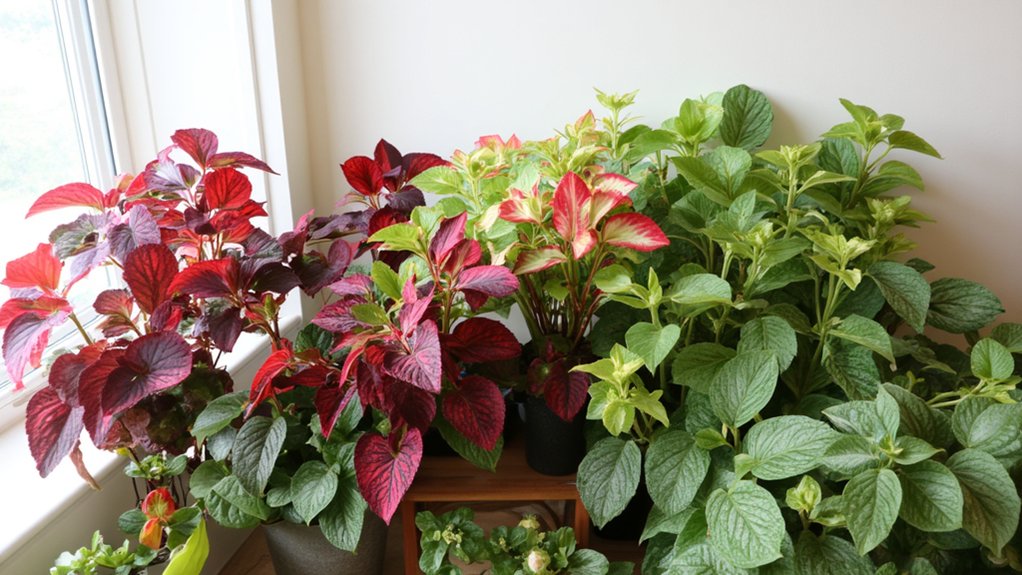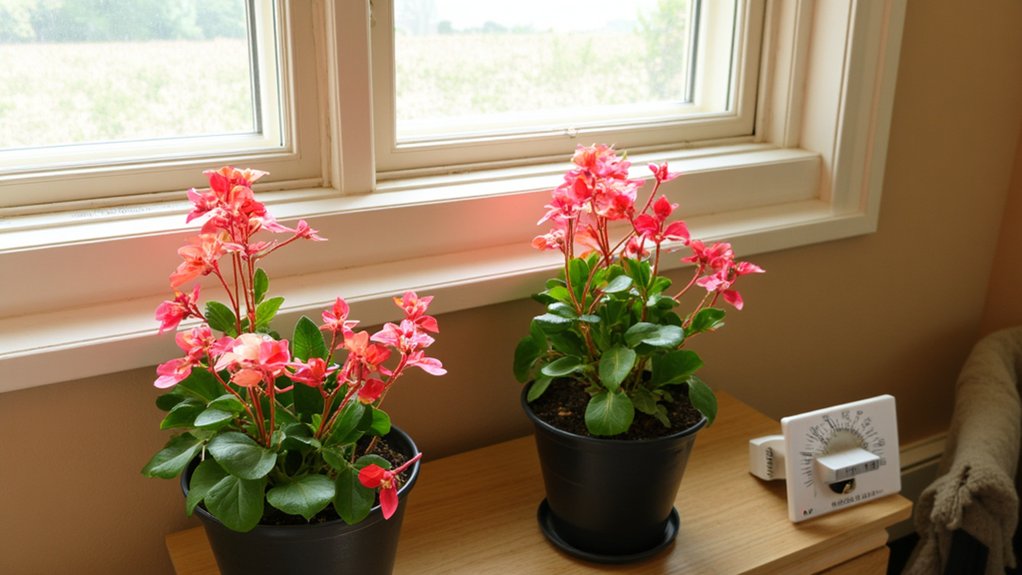You’ve probably noticed those striking begonias at your local garden center, with their eye-catching foliage and delicate blooms. While they’re not the most hands-off houseplants you’ll encounter, you’ll find that growing begonias indoors isn’t as intimidating as it might seem. With their diverse varieties and stunning appearances, from the rex begonia’s painted leaves to the angel wing’s cascading flowers, these plants can transform any indoor space – if you understand their specific care requirements.
Contents
Best Indoor Begonia Varieties to Grow

Begonias, with their stunning foliage and delicate blooms, make excellent indoor plants when you select the right varieties. For low-light conditions, you’ll find Rex begonias excel with their dramatic, spiral-patterned leaves in deep purples and silvers.
Angel-wing begonias, featuring pointed, wing-shaped leaves and cascading flowers, thrive in bright, indirect light and make perfect hanging specimens. If you’re dealing with humidity challenges, try wax begonias, which tolerate drier air better than most varieties.
For year-round flowering potential, tuberous begonias offer spectacular blooms in vibrant oranges, yellows, and pinks, though they’ll need a winter dormancy period.
Light Requirements and Placement
Success with indoor begonias starts with proper light placement. You’ll want to position your plant near an east or north-facing window, where it’ll receive bright, indirect sunlight for 4-6 hours daily. Direct afternoon sun can scorch the leaves, so use sheer curtains if you’ve got a south-facing window.
Watch for signs that your begonia isn’t getting enough light – leggy growth and fewer blooms are key indicators. If natural light is limited, you can supplement with LED grow lights positioned 12-18 inches above the plant. Keep the lights on for 12-14 hours during winter months to maintain healthy growth.
Watering and Humidity Needs

Since maintaining proper moisture is essential for indoor begonias, you’ll need to strike a delicate balance with watering. Water thoroughly when the top inch of soil feels dry, but don’t let the plant become waterlogged. During winter, reduce watering frequency by about 30%.
Your begonia will thrive in humidity levels between 50-70%. Place a humidity tray filled with pebbles and water beneath the pot, or use a small humidifier nearby. Misting isn’t recommended as it can lead to leaf spots and fungal issues.
If you notice brown leaf edges, increase humidity. For yellowing leaves, check if you’re overwatering.
Soil Selection and Potting Tips
A well-draining potting mix will protect your begonia from the moisture issues we discussed above. Create your ideal mix by combining two parts peat moss, one part perlite, and one part standard potting soil. You’ll want to make sure your pot has drainage holes and is just 1-2 inches larger than the plant’s root ball.
When potting your begonia, position it at the same depth it was growing previously, and leave about an inch of space between the soil surface and pot rim. Don’t forget to gently tamp down the soil around the roots to eliminate air pockets.
Temperature and Growing Conditions

Indoor begonias thrive in temperatures between 65-75°F during the day and won’t tolerate conditions below 60°F at night. You’ll need to protect them from drafty windows and heating vents, which can cause temperature fluctuations that stress the plant.
Maintain humidity levels between 50-70% by using a humidity tray or small humidifier. Your begonia will appreciate bright, indirect light, so place it near an east or north-facing window with filtered sunlight. If you’re growing under artificial lights, position them 6-12 inches above the plant for 14-16 hours daily.
During winter months, reduce watering frequency but don’t change their preferred temperature range.
Feeding and Fertilizing Schedule
Begonias need regular fertilizing during their active growing season, which typically runs from early spring through late fall. You’ll want to feed your plant every two weeks using a balanced, water-soluble fertilizer diluted to half strength, such as a 10-10-10 or 20-20-20 formula.
During winter months, when growth naturally slows down, reduce fertilizing to once monthly. If you’re using slow-release pellets instead of liquid fertilizer, apply them once every three months at the soil’s surface. Always check that the soil is slightly moist before fertilizing, as applying nutrients to dry soil can damage your begonia’s roots.
Pruning and Maintenance Techniques
Regular maintenance goes hand-in-hand with proper feeding to keep your begonia healthy and shapely. You’ll need to prune your plant every 4-6 weeks, removing any yellowed or damaged leaves at their base using clean, sharp scissors.
For bushier growth, pinch off the growing tips when stems reach 6 inches long. Don’t forget to wipe the leaves monthly with a damp cloth to remove dust, and trim off spent blooms as soon as they fade. During fall and winter, reduce pruning by half, focusing mainly on removing dead or diseased foliage to prevent fungal issues.
Common Problems and Solutions
Several common issues can affect your indoor begonia’s health, but most are easy to spot and treat early. If you notice yellowing leaves, you’re likely overwatering – reduce frequency and guarantee proper drainage. Brown, crispy leaf edges signal low humidity, so mist regularly or use a humidity tray.
Powdery mildew, appearing as white spots on leaves, requires immediate isolation and treatment with a fungicide. For pest problems, particularly mealybugs and spider mites, wipe leaves with isopropyl alcohol solution (1:4 ratio with water) weekly until resolved.
Root rot from waterlogged soil can’t be reversed, but you can propagate healthy stems in water to save the plant.
